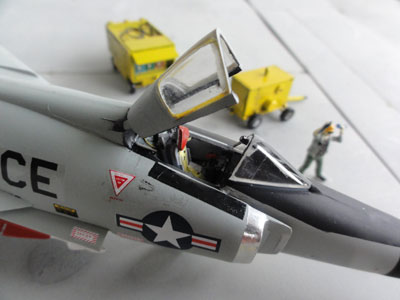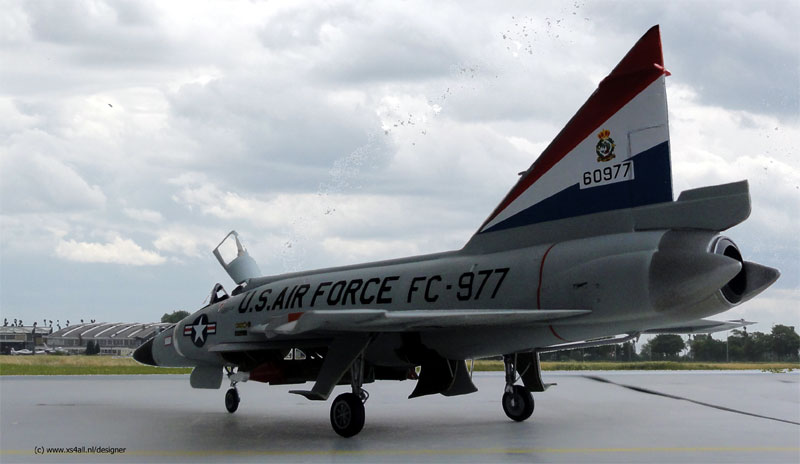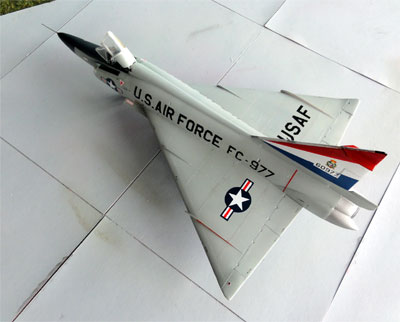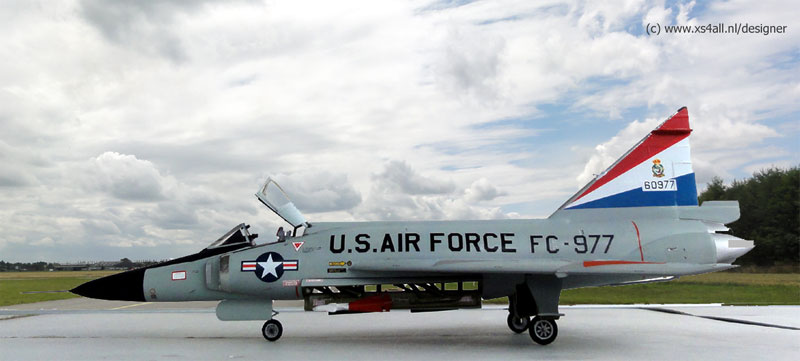32 FIS "Dutch" USAF squadron
1/72 scale Hasegawa kit of the F-102 Delta Dagger of the USAF in Europe
Go to TF-102 page..
I looked at my model stash and saw a whole pile of old Hasegawa kits of the F-102 Delta Dagger and the F-106 Delta Dart. These should be build and get a place in my model collection. It was decided to a a relatively simple "straight out of the box" built without too much effort.
But let's look briefly at their history.....
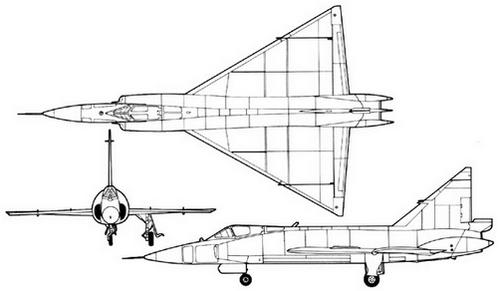
The Convair F-102 Delta Dagger was the first operational supersonic interceptor and delta-wing fighter of the USAF. Its main purpose was to intercept invading Soviet bomber fleets and no gun was fitted, only missiles to intercept. It used an internal weapons bay to carry both guided missiles and rockets. Its wing was designed after many aerodynamic high speed exploration using swept wings and delta wings like on the Convair XF-92. The F-102 got also a delta wing and the prototype flew October 1953 but experienced an unknown high drag. Tests revealed this to be caused by the pressure distribution along the aircraft length and cross-section. So as originally designed, it could not achieve supersonic flight. A major fuselage redesign was made, using the technique called area ruling where overall fuselage + wing forward cross section area was adapted station wise.
The USAF put the type into service April 1956, primarily in the Air Defense Command. It was armed with missiles only. During its career, a delta wing XX modification on some aircraft was also done with a cambered wing tip, reducing drag. From 1962 it was used in the Vietnam war until 1968.
The official name for the F-102 was Delta Dagger but the most common term used was "Deuce". Almost 900 planes were manufactured when production ended in September 1958. It was operated until 1976. The TF-102A was a two-seat training version with a side-by-side cockpit, leading to a very different appearance than the normal Delta Dagger.
Many of the
F-102s were transferred to United States Air National Guard duty by the
mid-to-late 1960s, and the type was retired from operational service in
1976. The follow-on replacement was the Mach-2 Convair F-106 Delta Dart,
which was an extensive redesign of the F-102. These series of aircraft
are often called "Century Fighters".
In the Netherlands, the USAF in Europe also deployed aircraft from the Dutch Soesterberg air base with the 312 fighter squadron. In 1956 the unit replaced their F-86 Sabres with North American F-100 Super Sabres. ( in July 1958 the unit was re-designated 32nd FIS and later 32nd TFS). In 1959 the 32nd received the signature Royal and the Dutch Royal Family (the House of Orange) crown and wreath were added to their emblem as long as the squadron remained in the Netherlands. They were the only USAF unit whose emblem included the royal crest of another nation. January 1959 saw the arrival of 18 new F-102A Delta Daggers and the 32nd was once again re-designated, this time as an FIS. On July 1, 1960 the 32nd FIS was assigned to the USAFE 86th Air Division at Ramstein Air Base in West Germany. The 32nd divided its aircraft in 3 flights, red, white and blue. The aircraft markings varied over the years from red-white-blue vertical tail, red-white-blue flaps but also they wore a green/brown camouflage scheme.
At the Soesterberg
MLM museum, a repainted F-102 was seen in this scheme in the 2000s:
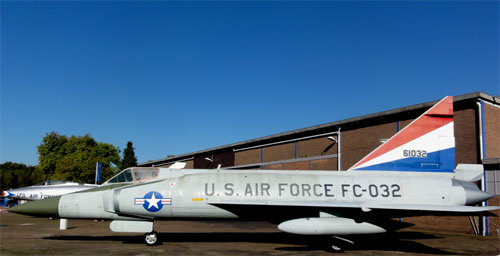
( photo I took at the old MLM, note: the
colours are not entirely correct...)
The 32nd (32
FIS) at Soesterberg flew the Delta Dagger from 1959 to 1969 when they transitioned
to the F-4E Phantom (as 32 TFS), followed by the later F-15
Eagles. At later periods the 32 TFS was even under operational control
of the Dutch air defense radar interceptor control at Nieuw Milligen ("Dutch
Mill") for coordinating interceptions. More 32 FIS/TFS
info on WIKIpedia...
The kit
The Hasegawa model is the only 1/72 injection plastic moulded model (also issued under the US Minicraft label). It was issued in the nineteen seventies. The model is pretty basic but quite reasonable in shape and can be detailed as desired to get a nice model. It has raised panel lines, and only a few parts. No real detail is present in the cockpit with only a very basic floor and seat (missing a control column) and no real wheelbay details. A missile bay is provided however, but it seems to be not deep enough. The Falcon missiles are rather crude with no separate fins. The kit was issued in several boxes with different decals which are rather basic.
The 1/72 model was re-issued in several
boxes
and decals, such as kit no. JS-047-180.
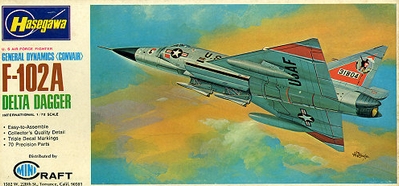 .
.
.
.
Another one was the Minicraft
kit with decals for two colorful aircraft, one from the 68th FS and one
from the 32nd FS

.... and with decals for an aircraft
from the California Air National Guard by another Minicraft issue:
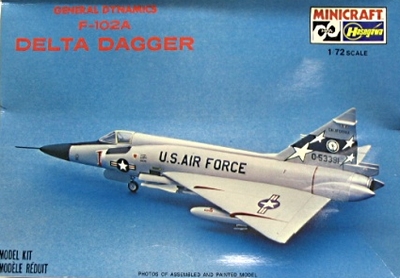
and in 2011, a combo kit package was
issued that included also the F-106 Delta Dart:
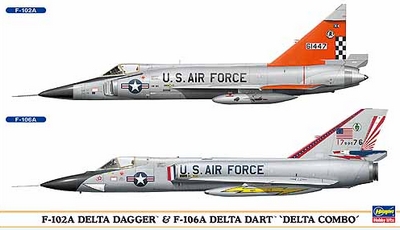
NOTE: MENG released some excellent 1/72 kits in 2012
Microscale issued many decal sheets for several squadrons in the USAF with also stencilling to further detail the model. Other after market decals from other manufacturers can also be found.
![]()
Assembly
The 1/72 model was assembled merely
as per instructions.
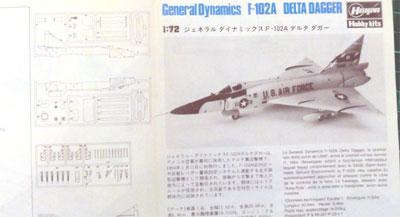
But I started by separating the lower
canopy frame and by cutting a slot in both fuselage halves at the rear
of the cockpit opening to cope with the canopy opening mechanism as I wanted
to set the canopy open. (no need to do this for a closed cockpit canopy).
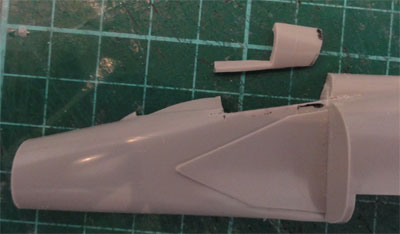
The cockpit tub was installed and
the fuselage assembled.
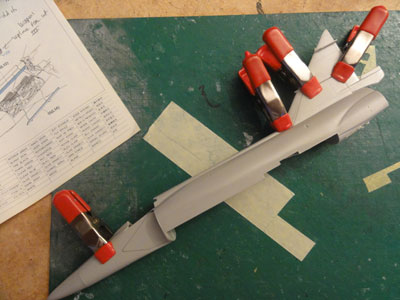
The separate air intakes are quite
deep so acceptable. I added thin card on the inside to close the intake
and any gaps.
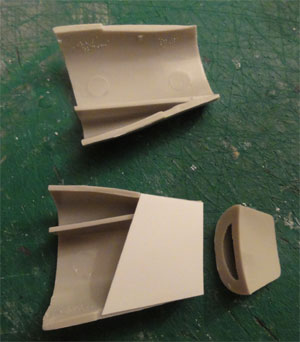 ..
..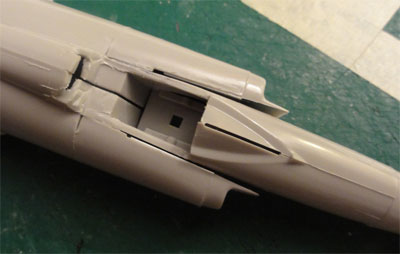
Here it is clear that quite some
sanding and clean up is need with putty.
The wing was quickly fitted and it
already looked the Delta Dagger.

Long gaps were filled and sanded
when dry, particularly at the lower wing leading edges. And after sanding....
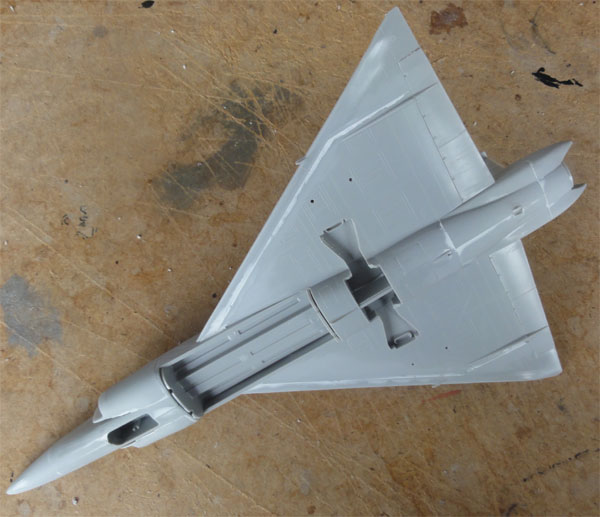
It was decided to keep the large missile
bay open. It is not very detailed but the six missile stations are interesting
and typical for the era with these kind of interceptors. (if you want a
closed bay, do not used the separate doors but used a piece of plastic
card made to fit and tweaked into the opening; this will result in a better
result and less work).
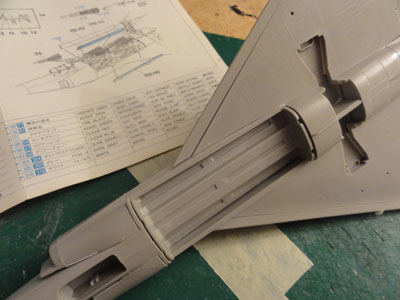
Note the large gaps in the bay, these
were filled with white glue. Not a lot of work was put into further detailling
the bay on this model.
After this was all done, the overall model got a base coat of light grey to check for any flaws. Corrections with putty and sanding was done in case of inperfections.
![]()
Time for detailing.
The cockpit got some detail from
sprue and a couple of instrument side consoles were added from cart. The
cockpit was painted medium grey, some instrument decals were used from
the kit and from the Microscale sheets.
The seat is rather basic. The upper
plastic of the seat was cut off and some bars added for the ejection rails.
Bay side walls were made from thin plastic card. The seat was painted medium
grey, harnesses and parapack suggested with tape and painted dark grey
with a red head rest.
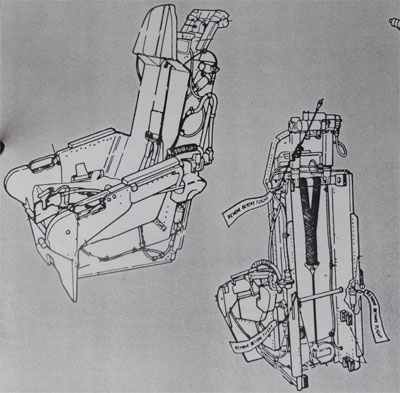 .
.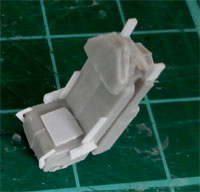
On the floor a pilot control stick
later was added with on top a "V" shaped handle.
With simple stretched sprue and rod, the gear doors got their retraction bars and so on. The wheelbays got details as well. Inside the wheelbays, some hydraulics were suggested from scratch card and rod. The wheelbays, inner doors and missile bay were painted interior green with some black wash for depth. Wheel tyres were painted typre black with aluminium wheelhubs. The kit wheels are OK and have a spoke hub pattern.
![]()
Colour scheme
The overall outside airframe colour
is USAF Air Defense Grey Fed.Std FS36473. I still had an old bottle
of enamel of Compucolor no. M145 for
the grey. This was applied with the airbrush
and the coat quickly covered but took 48 hrs to dry.
The black nose was also masked with low tack Tamiya tape and sprayed mat black. The wheel bays and the open missile bay and inside of the bay doors were painted with a paint brush interior green using White Ensign Models WEM ACUS09 enamel for Fed.Std 24151.
The smaller plastic bits were not
yet fitted on the model as I suggest first to do basic decalling for easier
handling.
Before doing that, the model got
a couple of coats of Johnson
Future / Clear / Pledge with the airbrush to avoid decal silvering
later as much as possible.
As I wanted a 32 FIS Soesterberg USAF plane, I was lucky to still get from my friend Bas special decals from an unknown firm. Probably from Microscale. (Note that Dutch Decal also issued decals for this scheme in the past). I noted after studying pictures that the US AIR FORCE titles varied somewhat in style and colour on various planes of the period. Some are very dark blue, others black. For this Deuce I used the US AIR FORCE decals from set no. 21A from an old AeroDecal set from Germany.
Studying photos, I also found that
the scheme varied a bit during the 32 FIS Deuce's operational service with
the squadron. Typically, the Deuces had the red-white-blue tail (representing
the Dutch flag) but also sometimes a green horizontal fin band was seen
with red-with-blue striping on the airbrakes and fuselage. The serial on the
tail is in a grey panel, unfortunately the decal has a white panel. Not
a lot can be done about this. The stars-and-bars were obtained from the
spares box for a good correct darker blue hue. The stencilling also saw
variations, on the model and mix from the kit decals and Microscale decals
were used with their fluids Micro Sol and Set being used.
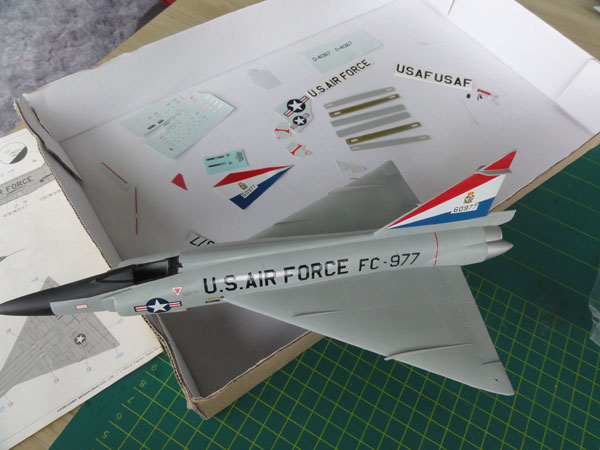
Various smaller stencilling like
"no steps" on the wing leading edge and trailing edge surfaces were added
using MicroScale decals.
The walkway panels on top of the
intake were cut to size from mat black decal from the spare box (not yet
seen in the picture).
![]()
Missiles
Typically, these aircraft carried
only missiles like the Falcon. In the kit only very basic Falcons are included.
These are quite rough. It was decided to get some missiles from Hasegawa
F-106 kits, but still these need refinement. The Falcon leading fins were
reduced in length to suggest an early AIM-4C Falcon as often used on the
first Deuces.
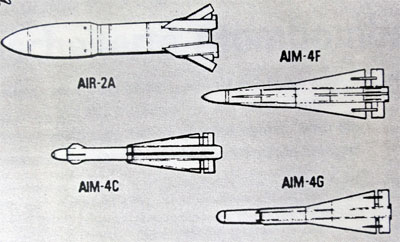 ..
..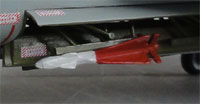
Slots were cut with a razor saw to
get a slot between the forward missile fins and the rear fins. Small bars
were added from sprue. Missiles were painted red with white front sections.
(You can also used missiles from the
Hasegawa 1/72 weapons set no. III , issued in the nineteen nineties).

![]()
Completing the model
- on most of the 32 FIS Deuces the
IR seeker is not seen in front of the windshield and also no antennas nor
anti collision light on the fuselage upper spine. Also no later data link
antennas on the lower tail area were seen. (This kind of equipment was
only fitted on USAF F-102's later on).
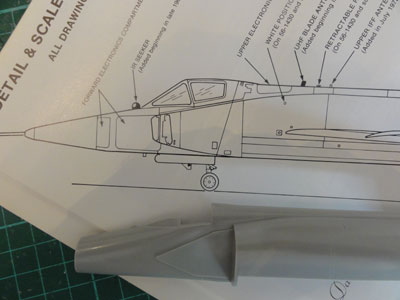
- on the intake not the typical red-warning pattern is set, but a simple grey pattern with metallic panels hand painted. On the wing fence, an orange section was painted with a tiny paint brush.
- the split plate to prevent pilot being blinded by reflections below the windshield kit part was replaced with thin card. A radar scope was added from rod and painted black.
- some weathering was done using a dry brush technique using 502 Abteilung oils, "engine grease". Particularly over the raised rivets this gives a good effect and adds life to the overall finish and look of the model.
- the air intakes got a metallic leading edge using some bit of Bare Metal Foil chrome decal, this was also set on the fin leading edge.
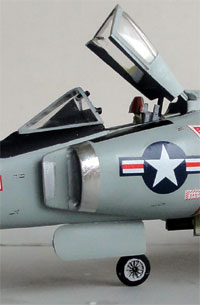 .
.
.
.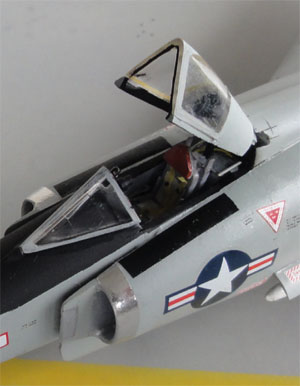
- the canopy windshield was already
separated through cutting by a razor saw. The frames were painted grey
with black internal details and set to dry. I did not bother with the yellow/brownish
edges.
- the rear canopy got the lower section of the cutt-out frame of the fuselage. A pair of stubs were added to the canopy rear for the opening mechanism. The canopy was set open in the already prepared slot and the windshield set in place on the nose. Some white glue was used to close a gap here.
- next the model got the gears, wheels and doors.
- the tail airflow horizontal plates were painted red to match the red decal.
- wing tips lights were drilled out,
got a drop of Micro Kristal Kleer and
painted transparant red and blue.
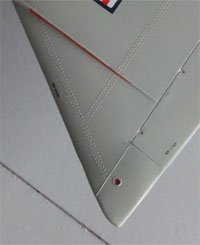
- nose pitot was added using a metal needle and the tail arrestor hook added from the kit painted grey.
Finally the whole model got a sealing matt varnish coat using Johnson Future / Clear / Pledge with 15% Tamiya Flat Base X-21 acrylic mixed in to get a semi-matt result.
![]()
That completes
the 1/72 model of this 32 FIS Deuce.
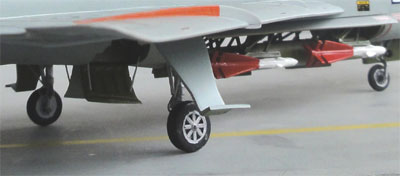
Note also the details on the wheel bay doors and the Falcon missiles
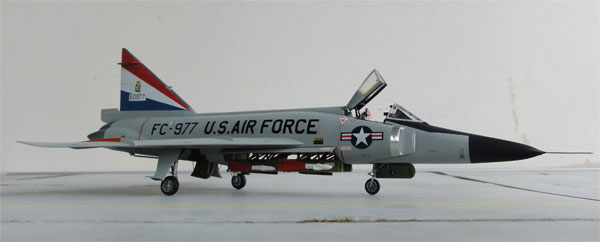

The model
sits nicely to the other "Century" series
of 1/72 models....
Regarding
the 32 FIS, also it is a nice companion to my 32 TFS F-4E Phantom and F-15C
Eagle.
Next is a Convair TF-102
Deuce trainer in 1/72 scale. Look here for the Modelling
Report
Internet:
http://en.wikipedia.org/wiki/Convair_F-102_Delta_Dagger
YouTube video F-102 and F-106
IPMS NL F-102 Walk Arounds
Books:
- F-102, In action series, Squadron
Signal publications ;
- F-102 Delta Dagger, in Detail &
Scale no. 35, Bert Kinzey ;
- 32 TFS, het enige Koninklijke Amerikaanse
squadron, Hans Loeber en Gerard Sprenger, (Dutch text), publisher Bataafsche
Leeuw, 1984 ;
- The Century Series: The USAF Quest
for Air Supremacy, 1950-1960 , Schiffer .
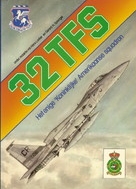 .......
.......
Back to 1/72 Models.......

(c) Copyright Meindert "designer"/ All rights reserved. Your comments are welcomed by webmaster
Created this page October 5, 2011
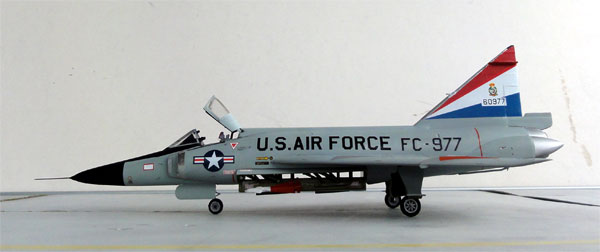
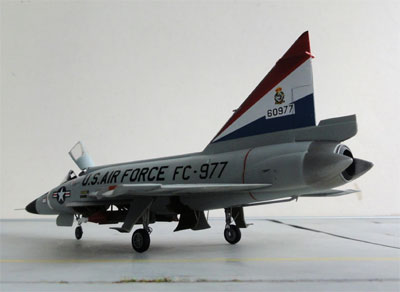 .
.